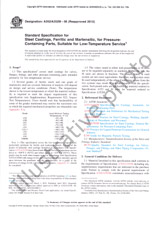We need your consent to use the individual data so that you can see information about your interests, among other things. Click "OK" to give your consent.
ASTM D6693/D6693M-20
Standard Test Method for Determining Tensile Properties of Nonreinforced Polyethylene and Nonreinforced Flexible Polypropylene Geomembranes
Translate name
STANDARD published on 1.7.2020
The information about the standard:
Designation standards: ASTM D6693/D6693M-20
Note: WITHDRAWN
Publication date standards: 1.7.2020
SKU: NS-999993
The number of pages: 6
Approximate weight : 18 g (0.04 lbs)
Country: American technical standard
Category: Technical standards ASTM
The category - similar standards:
Annotation of standard text ASTM D6693/D6693M-20 :
Keywords:
nonreinforced, percent break elongation, percent yield elongation, polyethylene, polypropylene, tensile break strength, tensile yield strength,, ICS Number Code 59.080.70 (Geotextiles)
Additional information
| Significance and Use | ||||||||||||||
|
4.1 This test method is designed to produce tensile property data for the control and specification of nonreinforced polyethylene and flexible nonreinforced polypropylene geomembranes. These data are also useful for qualitative characterization and for research and development. It may be necessary to modify this procedure for use in testing certain materials as recommended by the material specifications. Therefore, it is advisable to refer to that material's specification before using this test method. Table 1 in Classification D4000 lists the ASTM materials standards that currently exist. 4.2 Tensile properties may vary with specimen preparation, test speed, and environment of testing. Consequently, where precise comparative results are desired, these factors must be carefully monitored and controlled. 4.2.1 It is realized that a material cannot be tested without also testing the method of preparation of that material. Hence, when comparative tests of materials are desired, care must be exercised to ensure that all samples are prepared in exactly the same way, unless the test is to include the effects of sample preparation. Similarly, for referee purposes or comparisons within any given series of specimens, care must be taken to secure the maximum degree of uniformity in details of preparation, treatment, and handling. |
||||||||||||||
| 1. Scope | ||||||||||||||
|
1.1 This test method covers the determination of the tensile properties of nonreinforced geomembranes in the form of standard dumbbell-shaped test specimens when tested under defined conditions of pretreatment, temperature, and machine speed. 1.2 This test method can be used for testing materials thickness between 0.25 mm [0.010 in.] and 6.3 mm [0.25 in.]. Note 1: This test method is not intended to precisely measure
physical properties of a geomembrane for design purposes. This is
an “index test” intended to be used for quality control and
specification conformance purposes. The constant rate of crosshead
movement of this test lacks accuracy from a theoretical standpoint,
since crosshead movement as opposed to actual strain is used. A
wide difference may exist between the rate of crosshead movement
and the rate of strain in particular areas of the specimen since
the specimen does not have a uniform width or cross-sectional area.
This may disguise important effects or characteristics of these
materials in the plastic state. Use of an extensometer, not
included in this test, would more accurately measure strain and
strain rate but would still have limitations for some geomembranes.
Further, it is realized that variations in the thicknesses of test
specimens, as permitted by this test method, produce variations in
the surface-volume ratios of such specimens, and that these
variations may influence the test results. Hence, where directly
comparable results are desired, all samples should be of equal
thickness. Special additional tests should be used where more
precise physical data are needed. Test Method D4885 is a suitable performance test for
many applications.
1.3 The values stated in either SI units or inch-pound units are to be regarded separately as standard. The values stated in each system are not necessarily exact equivalents; therefore, to ensure conformance with the standard, each system shall be used independently of the other, and values from the two systems shall not be combined. 1.4 This standard does not purport to address all of the safety concerns, if any, associated with its use. It is the responsibility of the user of this standard to establish appropriate safety, health, and environmental practices and determine the applicability of regulatory limitations prior to use. 1.5 This international standard was developed in accordance with internationally recognized principles on standardization established in the Decision on Principles for the Development of International Standards, Guides and Recommendations issued by the World Trade Organization Technical Barriers to Trade (TBT) Committee. |
||||||||||||||
| 2. Referenced Documents | ||||||||||||||
|
We recommend:
Technical standards updating
Do you want to make sure you use only the valid technical standards?
We can offer you a solution which will provide you a monthly overview concerning the updating of standards which you use.
Would you like to know more? Look at this page.




 Cookies
Cookies
